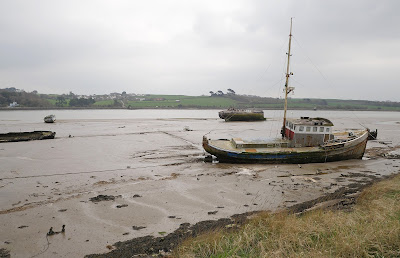Braunton Burrows and Staunton Sands
We picked up the Coast Path at Sandy Lane car park and continued to walk along a track with the dunes of Braunton Burrows between us and the sea. before very long I had spotted some more Speckled Woods (yesterday's was the first of the year) and a Comma (another first).
We passed through a golf course and emerged onto the Braunton to Croyde road at Saunton. We took an inland detour and were quickly rewarded by the sight of a lone Holly Blue (again my first of the year - as I write this I have just seen another in my garden) soon passing St Anne's chapel (1897), located in a rather lovely wooded setting. According to Pevsner it was intended to be the chancel of a larger church which was never built.
Returning to the road, we took a left which headed down to the car park behind Saunton Sands and headed uphill to rejoin the road. Above us was the imposing bulk of the art deco Saunton Sands Hotel (by Alwyn Underdown, about 1937).
As we climbed, we had our first view of the actual sea since a brief glimpse at Instow two days ago. It has been really strange walking so many miles along the Coast Path without being able to see the sea.
Further up the vast expanse of sand becomes visible, with the sand dunes behind on the left.
We crossed the road and climbed to follow a path along the side of the hill. This felt like the real Coast Path at last. An open path, flowers and grass on either side, views over the sea - and, as a special bonus, absolutely loads of Peacocks. Amazing to think that I saw my first of the year only two days ago. We passed around the headland and passed a building our taxi driver had told us about: a lighthouse-style structure right in the headland being built for some magnate and scheduled to appear on TV next year.
A little further on another modern house was nestling into the roadside. Rather a nice house I thought, but don't they have planning controls around here?
In the background is Croyde Sands, which we soon reached. Our first sight was of strata of rock twisted into what seemed to be right-angles from its original position.
Behind the large sandy beach were some inviting dunes.
We walked across the back of the beach and reached the car park at the far end where we had left the car.
Distance: 5 miles.
Grading: Easy.
Map: Explorer 139 (Bideford, Ilfracombe & Barnstaple)
Rating: Four stars.














































